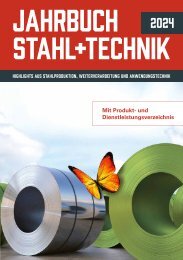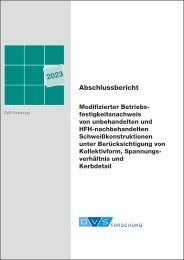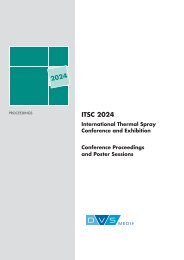STEEL + TECHNOLOGY 04/2019 EXTRACT
STEEL + TECHNOLOGY 04/2019 EXTRACT
STEEL + TECHNOLOGY 04/2019 EXTRACT
You also want an ePaper? Increase the reach of your titles
YUMPU automatically turns print PDFs into web optimized ePapers that Google loves.
<strong>STEEL</strong> <strong>TECHNOLOGY</strong> | 49<br />
From liquid steel to rolling<br />
Concepts and applications for higher<br />
efficiency and zero-waste<br />
To support the goal of sustainability, Danieli has expanded the portfolio of “green technologies.” Several energysaving<br />
and recovery processes, zero-waste and safety concepts have been developed over recent decades.<br />
Sustainability principles and<br />
guidelines<br />
In metals production “green technologies”<br />
are those that reduce emissions, waste<br />
by-products and resource consumption.<br />
Resources represent costs and so reducing<br />
the intake of raw materials and energy<br />
provides economic advantages to metals<br />
producers, but it also has benefits in terms<br />
of emissions reduction: gaseous (CO 2 ), liquid<br />
(dirty water), and solid emissions (slag).<br />
There also are maintenance advantages,<br />
as reducing resource consumption will limit<br />
intervention and the reuse of old equipment<br />
reduces the requirement for new<br />
resources.<br />
Personnel training and risk-analysis will<br />
limit failures or accidents, which represent<br />
costs both in terms of materials and of<br />
human beings. Also, we study start-ups<br />
and shut-downs because often these follow<br />
very un-optimized paths, in order to<br />
minimize consumption and equipment<br />
wear, to abate costs and to cut emissions<br />
and resource waste.<br />
Developing “green” production<br />
processes<br />
From conceptual modeling to the prototype,<br />
the design of new equipment relies<br />
more and more on computational modeling.<br />
CFD explores new configurations,<br />
DoE reduces the number of experiments,<br />
statistical tools transform sparse data into<br />
information, and predictive models convert<br />
observations into know-how.<br />
Environmental constraints can be implemented<br />
in these models like any other process<br />
parameters. For example, the Acou-<br />
Stack process was optimized by means of<br />
detailed CFD modelling.<br />
Increased process efficiency directly<br />
supports decreasing energy and resources.<br />
Machine-learning tools, using databases<br />
of failures, procedures or maintenance,<br />
have proven to be a valid aid to<br />
increasing performance in complex processes.<br />
The most notable new examples of<br />
Danieli green technologies that have<br />
resulted in new steelmaking technologies<br />
are the Energiron process, for reduction of<br />
iron ore using hydrogen, to minimize carbon<br />
emissions; and the MI.DA. concept<br />
for Endless Casting and Rolling, with low<br />
CapEx and OpEx, to serve regional markets.<br />
Resources for “green” research<br />
Model predictive control, machine leaning,<br />
and IoT are some ways to transfer research<br />
teams’ experience into customer operators,<br />
with adequate training to make the<br />
most of it. More often, research projects<br />
are followed by skilled employees in cooperation<br />
with the most specialized universities,<br />
as in the development of low NO x<br />
burners, or water-oil emulsion lubricants<br />
for aluminum cold-rolling.<br />
Figure 1. Danieli Automation dashboard for Energiron DRI plant (Picture: Danieli)<br />
Author: Rolando Paolone, Chief Technology Officer, Danieli SpA, Buttrio<br />
(UD), Italy – Contact: sustainable-technologies@danieli.com<br />
<strong>STEEL</strong> + <strong>TECHNOLOGY</strong> 1 (<strong>2019</strong>) No. 4


















